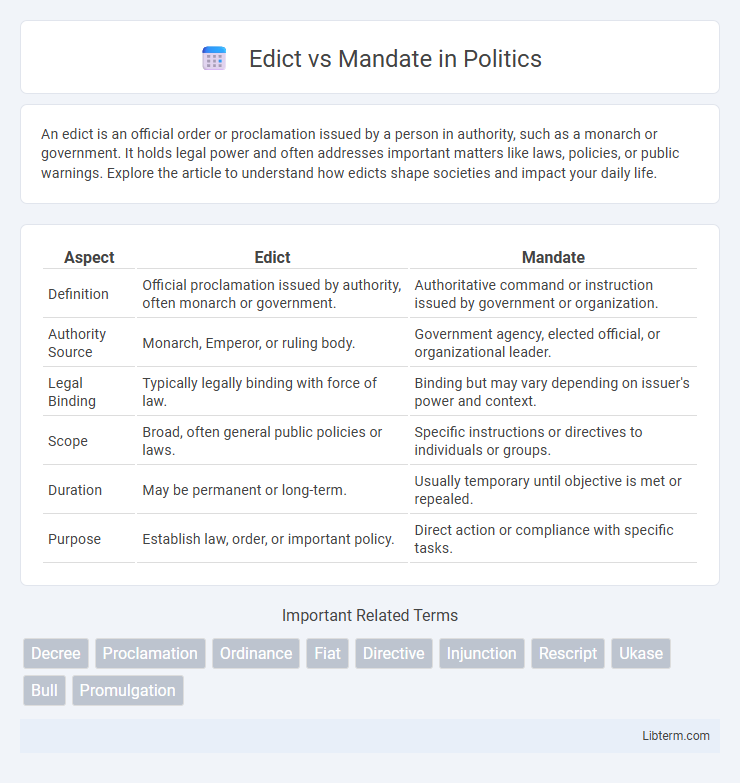An edict is an official order or proclamation issued by a person in authority, such as a monarch or government. It holds legal power and often addresses important matters like laws, policies, or public warnings. Explore the article to understand how edicts shape societies and impact your daily life.
Table of Comparison
| Aspect | Edict | Mandate |
|---|---|---|
| Definition | Official proclamation issued by authority, often monarch or government. | Authoritative command or instruction issued by government or organization. |
| Authority Source | Monarch, Emperor, or ruling body. | Government agency, elected official, or organizational leader. |
| Legal Binding | Typically legally binding with force of law. | Binding but may vary depending on issuer's power and context. |
| Scope | Broad, often general public policies or laws. | Specific instructions or directives to individuals or groups. |
| Duration | May be permanent or long-term. | Usually temporary until objective is met or repealed. |
| Purpose | Establish law, order, or important policy. | Direct action or compliance with specific tasks. |
Understanding Edict and Mandate: Core Definitions
An edict is an official proclamation issued by a sovereign authority or government, carrying the force of law and typically addressing specific rules or regulations. A mandate refers to an authoritative command or instruction issued by a governing body or official, often requiring compliance from individuals or organizations within its jurisdiction. Understanding the core definitions highlights that edicts are formal legal pronouncements, while mandates focus on directives enforcing policy or action.
Historical Origins of Edicts and Mandates
Edicts originated in ancient civilizations like Rome and China as public proclamations issued by sovereigns or rulers to establish laws or decrees, often inscribed on stone or metal for permanence and widespread dissemination. Mandates have roots in diplomatic and administrative contexts, frequently used by governing bodies or higher authorities to enforce specific policies or orders within a hierarchical system. Both edicts and mandates reflect historical mechanisms of authoritative communication, with edicts emphasizing public legal pronouncements and mandates focusing on binding instructions within institutional frameworks.
Legal Authority: Edicts vs. Mandates
Edicts derive their legal authority from sovereign or executive powers, often issued by monarchs or heads of state with unilateral decision-making abilities. Mandates typically arise from legislative or administrative bodies, carrying binding directives that require compliance by subordinate entities or individuals. Both forms establish enforceable rules, but edicts emphasize absolute authority, while mandates often reflect delegated or statutory power.
Key Differences Between Edict and Mandate
An edict is a formal proclamation or authoritative order issued by a sovereign or government, often publicized to enforce laws or policies, whereas a mandate is a command or authorization given to an individual or institution to carry out a specific task or function. Edicts typically have a broader scope, applying to the general population, while mandates are more specific, targeting particular entities or actions. The key differences lie in their purpose, scope, and formality: edicts emphasize public decree and law enforcement, whereas mandates focus on delegated authority and execution.
Use Cases: When to Issue an Edict or a Mandate
An edict is typically issued by a sovereign or government authority to announce legal decrees or regulations that require public adherence, usually in matters of law, governance, or policy enforcement. Mandates are often used in organizational or operational contexts, such as by companies or institutions, to direct specific actions or compliance within internal workflows or departments. Use an edict to establish broad legal or public obligations and a mandate to enforce targeted instructions and procedural directives within controlled environments.
Impact on Society: Edicts Compared to Mandates
Edicts often carry the force of law issued by sovereign authorities, shaping social norms and public behavior through top-down directives with broad societal implications. Mandates specifically require individuals or groups to perform or abstain from actions, frequently impacting public health, safety, or welfare more directly and with measurable outcomes. Society experiences edicts as overarching legal frameworks, while mandates produce targeted compliance and immediate behavioral changes that drive collective action.
Notable Examples of Edicts in History
Notable examples of edicts in history include the Edict of Milan, which granted religious tolerance to Christians in the Roman Empire, and the Edict of Nantes, which provided rights to French Protestants. The Ashoka Edicts, inscribed on pillars and rocks across India, promoted Buddhist moral teachings and governance principles. These edicts served as authoritative proclamations issued by rulers to communicate policies and legal directives to their subjects.
Significant Mandates in Modern Governance
Significant mandates in modern governance often involve legally binding directives issued by government authorities that require compliance from individuals, organizations, or subordinate institutions, ensuring policy implementation and regulation enforcement. Unlike edicts, which historically functioned as proclamations or public announcements with varying degrees of obedience expected, mandates carry explicit legal authority and are instrumental in translating legislative decisions into actionable obligations. Examples include public health mandates, environmental regulations, and educational requirements that shape societal behavior and governance outcomes.
Challenges and Controversies Surrounding Edicts and Mandates
Edicts and mandates often face challenges related to their enforcement and public acceptance, particularly when they impose sudden restrictions or require significant behavioral changes. Controversies arise from perceived overreach of authority or lack of transparency, fueling public resistance and legal disputes. The ambiguity in the scope and duration of these directives can further complicate compliance and governance.
Choosing Between Edict and Mandate: Best Practices
Choosing between an edict and a mandate depends on the scope and authority required for implementation, with edicts typically serving as authoritative proclamations issued by sovereign powers and mandates acting as formal orders from higher authorities to subordinate entities. Best practices suggest using edicts when broad, public declarations are necessary to establish new laws or policies, while mandates are more effective for directing specific actions within organizations or government bodies. Clear communication, legal clarity, and alignment with organizational goals ensure the chosen instrument achieves its intended regulatory impact efficiently.
Edict Infographic

 libterm.com
libterm.com